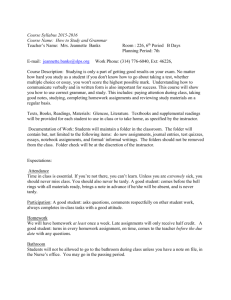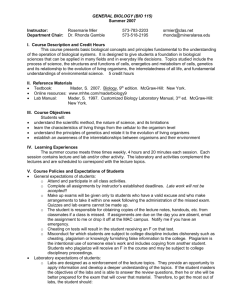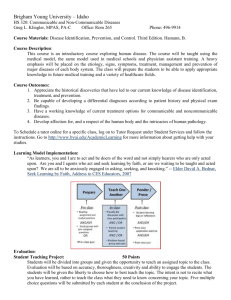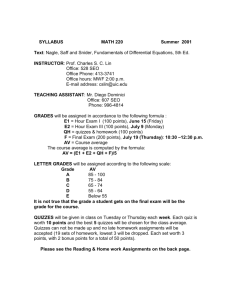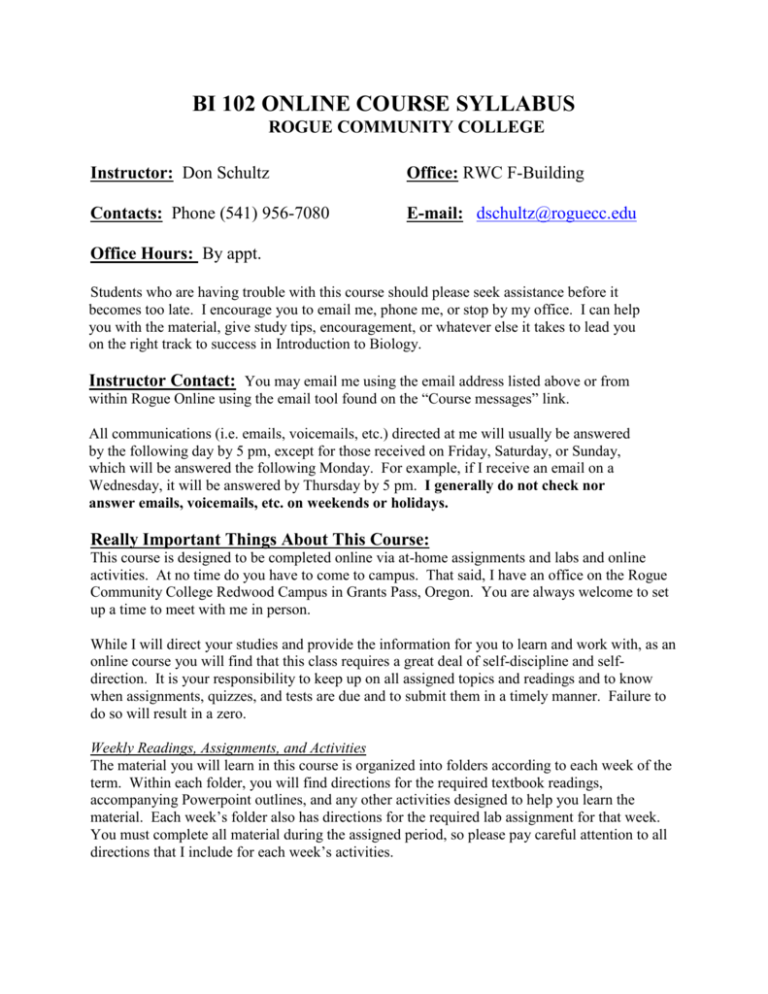
BI 102 ONLINE COURSE SYLLABUS
ROGUE COMMUNITY COLLEGE
Instructor: Don Schultz
Office: RWC F-Building
Contacts: Phone (541) 956-7080
E-mail: dschultz@roguecc.edu
Office Hours: By appt.
Students who are having trouble with this course should please seek assistance before it
becomes too late. I encourage you to email me, phone me, or stop by my office. I can help
you with the material, give study tips, encouragement, or whatever else it takes to lead you
on the right track to success in Introduction to Biology.
Instructor Contact: You may email me using the email address listed above or from
within Rogue Online using the email tool found on the “Course messages” link.
All communications (i.e. emails, voicemails, etc.) directed at me will usually be answered
by the following day by 5 pm, except for those received on Friday, Saturday, or Sunday,
which will be answered the following Monday. For example, if I receive an email on a
Wednesday, it will be answered by Thursday by 5 pm. I generally do not check nor
answer emails, voicemails, etc. on weekends or holidays.
Really Important Things About This Course:
This course is designed to be completed online via at-home assignments and labs and online
activities. At no time do you have to come to campus. That said, I have an office on the Rogue
Community College Redwood Campus in Grants Pass, Oregon. You are always welcome to set
up a time to meet with me in person.
While I will direct your studies and provide the information for you to learn and work with, as an
online course you will find that this class requires a great deal of self-discipline and selfdirection. It is your responsibility to keep up on all assigned topics and readings and to know
when assignments, quizzes, and tests are due and to submit them in a timely manner. Failure to
do so will result in a zero.
Weekly Readings, Assignments, and Activities
The material you will learn in this course is organized into folders according to each week of the
term. Within each folder, you will find directions for the required textbook readings,
accompanying Powerpoint outlines, and any other activities designed to help you learn the
material. Each week’s folder also has directions for the required lab assignment for that week.
You must complete all material during the assigned period, so please pay careful attention to all
directions that I include for each week’s activities.
Quizzes and Exams
Every week, you will have an online 10 point quiz covering material from that week’s folder.
The quizzes will be short (10 questions) and multiple choice. They will be timed, so you will not
have the opportunity to look up all the answers if you want to finish in time. You must know the
material well to succeed on the quizzes. Keep in mind that once you begin the quiz, you cannot
restart it and must finish in the time allotted. Quizzes will be available for you to take anytime
during the assigned week and will close at the end of the week at 11:59 pm.
Three times during the quarter, you will have an online 100 point lecture test (exam). The tests
will be multiple choice and true/false. Like the quizzes, each test will be timed. You will
generally have a window of about seven days to take each test. I will always remind you of
upcoming tests and the dates when the tests open and close. Each test will cover all text
readings, Powerpoint outlines, and any online activities assigned since the previous test. The
tests are not cumulative over the material covered by previous tests.
All quizzes and tests can be accessed from the weekly assignment folders which are located
under the “Course Lessons” link on the left menu of our homepage.
Labs
Lab exercises will be performed at home using the materials in your eScience Labs kit. These
kits are purchased separately by you according to the directions listed below. The cost of the kit
is $149 + shipping. You should purchase your kit in advance so that you are ready to do labs the
first week of the term. Generally, it takes 6-10 business days from the time you order your kit
until you receive it, so plan ahead.
To order your kit, follow the steps outlined below:
Go to www.esciencelabs.com
Go to the top right corner and create a new account (if you do not have one already)
Once logged in, click on the “Have a Code” button on the upper right side of the page
Enter your kit SKU, which is RCCBIO10, and proceed to check out
Once you have received your kit, please go through the packing list included in the kit and make
sure that all the materials that are supposed to be in the kit are actually there. If anything is
missing or broken, please contact eScience Labs right away and they will replace the item—but,
you must contact them right away because after the first 30 days, they will not replace the item.
While I will give suggestions and help you if you run into problems, it is up to you to ensure that
you set up and complete each lab in a timely manner. You will be able to access each week’s
assigned lab activities through each week’s assignment folder on Blackboard as well as through
the eScience website.
Lab activities will be assigned each week; however, pay close attention to the due dates, as
they will generally be due at one of three assigned lab deadlines throughout the quarter. It
is your responsibility to make sure that they get done and turned in by the assigned
deadline for that lab. For each lab that you do, a lab report, questions/answers, tables,
graphs or photos may be required to be submitted for grading. Please refer to the
instructions for each week’s assignments for exact details.
Each lab report must be submitted to me as a MS Word compatible file or pdf. This means
it must be in a .doc, .docx, .rtf, or .pdf file format. If it is not submitted in one of these
formats, it WILL NOT BE GRADED. All lab reports must be submitted in the designated
“Drop Box” in each weekly lesson folder.
You are welcome to submit your labs anytime before the due date. However, keep in mind that I
generally will not grade labs until the due date. As a rule, you should expect to receive your
grade for a lab by one week after the due date.
To verify that the lab was actually performed, you may also be required to attach a digital
photograph of your lab experiment in progress, along with your lab report.
If you have any questions or problems with your labs, remember that you can always ask me for
help.
Lab Exam
During the last week of the term, you will have a 100 point lab exam. Like the other tests, the
lab exam will be online and will be timed. It will be cumulative over all lab material (that is, it
will cover everything you did in all the labs from the beginning of the term until the end) and
will include specific questions about lab experiments, procedures, principles, and microscopic
studies.
Grades
Your grades can be accessed via the “Grades” link found on the left menu of our homepage.
You may access this at any time for an up-to-date total of your points.
Prerequisites for this Course: RD 30 and MTH 60
General Course Description: This course in intended for non-biology majors. Students
will be introduced to the field of zoology, specifically the disciplines of systematics, physiology
and comparative anatomy with an emphasis on human systems. This class will be taught
completely online in weekly modules consisting of reading assignments, online activities,
quizzes, tests, and hands-on lab activities which will be performed at the student’s home using a
designated lab kit.
Course Objectives:
Expected Course Outcomes:
Having successfully completed the course, the student will be
able to:
1.
Can explain, diagram, draw, list and/or
describe the basic structure and important
characteristics of vertebrates.
2.
Can explain, diagram, draw, list and/or
describe homeostasis.
3.
Can explain, diagram, draw, list and/or
describe structure and function of digestion.
4.
Can explain, diagram, draw, list and/or
describe structure and function of the lungs
and respiratory system.
5.
Can explain, diagram, draw, list and/or
describe structure and function of the heart
and the circulatory system.
6.
Can explain, diagram, draw, list and/or
describe structure and function of the
immune system and response
7.
Can explain, diagram, draw, list and/or
describe structure and function of the
endocrine system and hormones
8.
Can explain, diagram, draw, list and/or
describe structure and function of the
nervous system.
9.
Can explain, diagram, draw, list and/or
describe structure and function of the
kidneys and the urinary system. Can
analyze the results of urinalysis.
10.
Can explain, diagram, draw, list and/or
describe structure and function of
reproduction and development.
11.
Demonstrate future employment skills by
being on time, handing in assignments
when due, and coming to class prepared to
work with the appropriate tools.
12.
Demonstrate the ability to work
cooperatively with other students and staff.
13.
Develop a problem solving approach to
problems in biology.
ILO
COM3— (Collaborates
effectively to achieve
course/learning goals)
Assessment Methods:
Assessment rubric for COM3 will
be used to measure student
progress toward mastery of
COM3.
Required Materials:
Text:
Biology: Life on Earth, 10th edition by Audersirk, Audersirk, & Byers.
Upper Saddle River, NJ: Pearson / Prentice Hall (available in the bookstore or online
from various book sellers)
Lab Kit: Kit # RCCBIO10 ordered from eScience Labs, Inc.
-the lab kit includes access to all the lab activities required for this course
*Note: the lab kit must be purchased separately from your text
Software: You will need to be able to view MS Word and PowerPoint files. If you don’t already
have MS Word or Powerpoint, you can try using Open Office software to view these files. Open
office can be downloaded here.
Textbook Website: The publisher of your textbook maintains a companion website called
“Mastering Biology”, which can be found at www.masteringbiology.com. This site contains
study guides, chapter practice quizzes, web tutorials, animations and many other resources to
help you in this course. This site is not affiliated with our BI 102 course homepage and is
optional for your use. Most students will find it beneficial, though. To access it, you will need
an access code which is included in brand new copies of the larger, hardbound version of our
text. If you bought your book used or if you bought the smaller, custom edition of the text, you
will likely not have a card.
To use the website, go to the web address mentioned above and enter your information to gain
access. If you do not have a card, you may purchase access at the website. Remember, though,
that this is optional and not required for this course! The internet has many other free resources
which you may find just as useful.
Objectives will be met through the following methods of evaluation:
lecture exams that require the synthesis of material, analysis of data, and conclusions to be
drawn, weekly quizzes, and lab participation. Exams and quizzes are only available to take
during the dates and times designated by your instructor. Make-ups will not be given.
Note: technology often fails; do not wait until the last minute to finish your quizzes and
tests.
1.
Lecture: There will be three exams each worth 100 points. The material on these
exams is not cumulative, but previously learned material may be needed to answer
current exam questions.
2.
Lab: As this is a lab science course, at least 70% of the labs must be accomplished
with a “C” grade or better in order to get a passing grade for the course. For example,
if you had an 80% in the class, but only turned in 50% of the lab assignments, you
would still receive a failing grade for the course. Lab write-ups will be completed for
each lab. There is also a cumulative lab exam at the end of the term.
3.
Quizzes: There will be a quiz given each week covering that week’s material.
Course Grading Scale and Points:
Lecture exams
Lecture Quizzes
Lab Reports
Lab Exam
Total points possible
300 points
70 points
100 points
100 points
570 points
89.5 % - 100.0 % = A
79.5% - 89.4 % = B
69.5% - 79.4 % = C
59.5% - 69.4 % = D
00.0% - 59.4 % = F
Attendance and Drop Policy:
While this is a fascinating course, it is also a difficult course. Students who do not keep up on all
assignments and put in maximum effort will have a very difficult time succeeding in this class.
It is the student’s responsibility to ensure that he/she keeps track of all course assignments and
deadlines and complies with them.
Student Responsibilities:
1. It is each student's responsibility to be aware of all college procedures, such as how to
add, drop, or withdraw from a class, and the available student services. For more
information, refer to your Student Handbook, Schedule of Classes, and the Student
Rights, Freedoms, and Responsibility Statement.
2. CHEATING AND PLAGIARISM ARE VIOLATIONS OF THE COLLEGE
POLICY AND ARE CONSIDERED SERIOUS OFFENSES. THE DEPARTMENT
OF BIOLOGICAL SCIENCES TAKES ALL INCIDENTS OF ACADEMIC
DISHONESTY SERIOUSLY AND ACTS ACCORDINGLY: THIS INCLUDES A
FAILING GRADE FOR THE COURSE OR EXPULSION FROM THE COLLEGE.
Students With Disabilities:
Any student that feels that he or she may need an academic accommodation for any disability,
such as vision, hearing, orthopedic, learning disabilities, psychological or other medical
conditions, should make an appointment with the Support Services Office (located in the
Wiseman Tutoring Center on the Redwood Campus, or Wards/G-207 at the Riverside campus).
Examination Policy:
There will be NO opportunity to make up missed exams. This should never be an issue for
you, as the exams may be taken anytime during the assigned window of one week. Failure to
take the exam will result in a zero.
Syllabus Disclaimer:
A syllabus is designed to provide the student with a guide to course procedures, requirements,
and grading policy. Sometimes it is necessary to alter the assignments or point totals due to
availability of materials, emergencies, or to create the most productive learning program for the
success of the student. I reserve the right to alter the grade total, to change the assignments to
deal with emergencies as needed, or to alter the suggested test or lab schedule to create a more
productive learning program for student success.
Time Management
The ability to successfully manage one’s own time is critical to the success of students in
general. It is of particular importance to students in Web-based classes.
I expect that you will spend at least as much time (or more) on this Web-based course as
you would on an in-class course. A general “rule of thumb” is that a successful college student
will spend a minimum of 12—15 hours per week on a 4-credit course. For an in-class course,
that time includes attending class, working on class projects, and reading and studying outside of
class. In this Web-based course, we will be completing a variety of learning activities which
will require the same, if not more, time than an on-campus/in-person course.
You must also pay very close attention to the due dates for each week’s quizzes, labs and any
exams. The due dates can be found in each week’s folder in the document titled “Directions for
Week X Assignments”.
Netiquette
Netiquette refers to etiquette on the Internet. The guidelines below generally apply to e-mail and
other types of online communication. Please keep these basic guidelines in mind as you
communicate.
1. Read messages carefully to make sure that you understand them.
2. Carefully read what you send in order to reduce misunderstandings.
3. Label humor or sarcasm clearly. One method for this is using emoticons, such as
8) ;-) :-).
4. Know your audience. Make sure that the people to whom you are sending your
message are members of your intended audience.
5. Be patient with people new to discussion boards, e-mail, and other communication
technologies.
6. Keep messages as straightforward and concise as possible. Recipients may hit the
"delete" button if they see a lengthy, cluttered, and unclear message.
7. Quote relevant parts of a message to which you are responding so the original sender
(or others who may read the email) understands the context of your response.
8. Make sure your name and the message's subject are included.
9. Focus on one topic in each message. If you try to cover multiple topics, some of your
points may be missed.
10. Type in lowercase. Using uppercase means that you're SHOUTING.
11. Keep in mind that for many Internet users, English is not their first language. Ask
senders for clarification before making judgments and jumping to conclusions.
STUDENTS ARE RESPONSIBLE FOR ALL ANNOUNCED CHANGES IN THE
COURSE SYLLABUS
Tentative Schedule of Lecture Topics & Readings:
Week
1
Chapter
18
23
Topic/Exam
Intro. to Bio. 102 / Systematics
Invertebrate Diversity
2
24
31
Vertebrate Diversity
Homeostasis and Animal Body Organization
3
32
Circulatory System
4
Exam #1: Chapters 18, 23, 24, 31, 32
33
Respiratory System
5
34
35
Nutrition and Digestive System
Urinary System
6
36
37
Immune System
Endocrine System
7
Exam #2: Chapters 33, 34, 35, 36, 37
8
38
38/39
Nervous System
Nervous System (cont.)
9
40
41
Muscular Skeletal System
Reproductive System
10
42
25
Animal Growth & Development
Animal Behavior
11
Review
Exam #3: Chapters 38/39, 40, 41, 42, 25
Tentative Schedule of Laboratory Topics
Week
1
Lab Exercise
Human Body Tissues
2
Features of the Cardiovascular System
3
Organs of the Respiratory System
4
Breathing & Respiratory Vol. & Cap.
5
Organs of the Digestive System
Action of a Digestive Enzyme
6
Structure of the Kidney
Urinalysis
7
Nervous System and Senses
8
Nervous System and Senses cont.
9
Lymphatic System
10
Male Reproductive System
Female Reproductive System
11
Lab Exam
Study Skills:
Biology is a challenging and involved field of study that requires a considerable effort on the part
of the student. Students should commit a portion of each day for reviewing lecture and reading
notes. Nothing can take the place of good study habits; the following is a list of helpful hints:
1.
Read the text before doing assignments.
2.
ASK QUESTIONS!
3.
Teach the material you are learning to another person—educational studies show
that the very best way to learn something is to teach it!
4.
Write down new or difficult words on 3x5 cards. Put definitions or concepts on
the back. Carry these flash cards and use them to quiz yourself.
5.
Carefully study diagrams and illustrations.
6.
While reading, use markers to highlight key ideas.
7.
After finishing a paragraph restate the main ideas in your own words: summarize.
8.
Take good notes! Re-write your notes on blank paper to help you remember the
information better.
9.
Review material on a daily basis: flash cards, reading, notes, and review
questions. DO NOT CRAM FOR EXAMS!
10.
Answer the review questions at the end of the chapter.
11.
Build mental images, models, & mnemonic devices of what is discussed or read.

